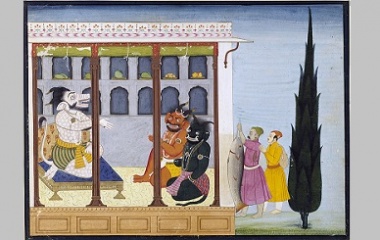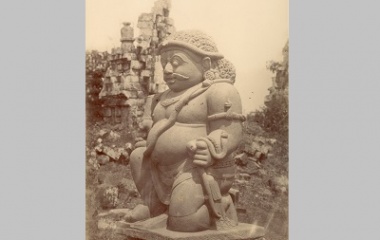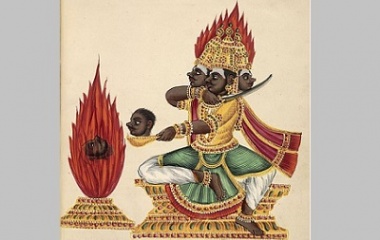What is a Rakshasa?
A Rakshasa (female Rakshasi) is a bloodthirsty demon, banished from the realm of the gods and forced to live on earth, making mankind its prey. While most of the beasts are as evil as evil can be, a few of them have formed alliances with noble armies and performed heroic feats in battle.
Characteristics
Physical Description
A Rakshasa’s appearance is as hideous as its flesh-eating habits. Their shape is basically human, but they are tall, towering over ordinary men and women, and their limbs are twice as thick as a man’s. A set of curved fangs curl from the corners of their lips; wicked claws sprout from their fingers and toes, and two bull-like horns grow from their heads. Average Rakshasas have mottled skin, dark hair, and piggish eyes, but more powerful beasts have glowing eyes and fiery manes. The strongest warlords can have extra heads and arms.
Special Abilities
The Rakshasas’ brute strength and passion for carnage alone could make any of them a terrifying foe. Still, they possess a weapon even more powerful than fangs, horns, or claws. They are master magicians.
The demons can fly, spit fire, and possess dead corpses, using them to attack their enemies, but their favorite branch of magic is illusion. They are amazing shapeshifters, able to take on any form they please, and they are famous for dreaming up near-impossible riddles, which they to confuse and trap victims.
Weaknesses
Because of their physical strength and their status as demigods, Rakshasas are extremely difficult to kill. Most warriors need magical weapons, given to them by the gods, to bring down one of these monsters. However, some of the greatest heroes of Hindu lore have been able to kill a Rakshasa with their bear hands.
Although these demons can be active during the day, they are undoubtedly stronger at night. They have more energy, and their magic is more potent after the sun goes down.
Famous Myths
Origin
The most popular explanation for the existence of the horrible Rakshasas is that the race was created accidently. When Brahma, a Hindu creator god, fell asleep at the end of the Satya Yuga, the golden age of humanity, a race of demons were born from his heavy breath. Immediately, the creatures turned on their creator and began devouring Brahma himself. When he awoke to their biting and clawing, Brahma cried out, “Rakshama!” (“Help me!”) His cry was answered by another god, Vishnu, who saved Brahma by banishing the terrible new race of demons to earth, where they were named after Brahma’s cry for help.
Battle of Lanka
According to Ramayna, an ancient Hindu text, an entire kingdom of Rakshasas once existed on an island fortress called Lanka. The demons were able to coexist because they were ruled by a king who was literally ten times more ferocious than all the rest of them: King Ravana, a ten-headed super monster.
Eventually, the darkness and terror that was beginning to leak out of Lanka attracted the attention of Rama, a heroic warrior who led an army of monkeys. Rama reached out to King Ravana’s brother, a surprisingly noble creature named Vibhishana, and with his help, he was able to storm the evil fortress.
A terrible battle blossomed in the fortress, with Rama’s monkeys fighting desperately against the giant demons, even demons mounted on elephants! The tide of the battle finally changed in favor of the monkeys when Rama used a magical weapon, given to him by Brahma, to kill the greatest of the Raksasha warriors. Soon, King Ravana was killed as well, and Lanka surrendered to Rama.
The Hero Bhima
The ancient Mahabharata chronicles the travels of Bhima, a hero from Pandava who became a prolific killer of Rakshasas. Remarkably, Bhima needed neither an army nor even a special weapon to defeat the giant monsters; he could fight, and kill, them with his bare hands.
Bhima’s career began when he and his friends travelled into a dark forest, overrun with man-eating demons. The company went along peacefully during the day, but when they laid down to sleep under the forest canopy at night, they were immediately targeted by a vicious Rakshasa named Hidimba. Hidibmba was determined to eat all the men, so he sent his sister, Hidimbi, to gather more information about their weapons and sleeping arrangements. Hidimbi slunk into the Pandavan men’s camp, excited by the feast to come, but when she saw the hero Bhima, her heart melted. She was instantly in love with him, and she warned him about her brother’s plan. When Hidimba attacked, Bhima was ready to meet him, and the monster was dead in no time.
After his victory over Hidimba, Bhima had no fear of Rakshasas. He continued travelling across Pandava, and whenever he found a village that lay in dread of an evil demon, he would astound the village people by willingly going to duel the demon. In this way, he killed some of the most ferocious monsters of his time: Bakasura, Kirmira, and Jatasur.
Still, Bhima hadn’t completely hardened his heart against the Rakshasa race. He loved Hidimbi, the Rakshasi who had waken him in a dark forest to warn him that her brother was about to attack. Together, they had a Rakshasa son named Ghatotkacha. Bhima and Ghatotkacha were very loyal to each other, and they often fought side-by-side in battle.
Buddhist Adaptation
As Buddhism rose in popularity, it absorbed many of the characters from Hindu mythology. Buddhists associated the Rakshasas with Mara, a sort of deity who represented all the vices which could attack a follower of Buddha on the path to enlightenment.
In one story, the Buddha himself encountered an unfriendly Rakshasa, who threatened to devour him if he was unable to answer his riddles. Fortunately, the all-knowing Buddha answered the questions with ease, and the demon was so impressed that he became a follower of Buddhism. Later, the Buddha gathered more followers in a group of Rakshasa sisters, who swore to uphold and protect the Lotus Sutra.










